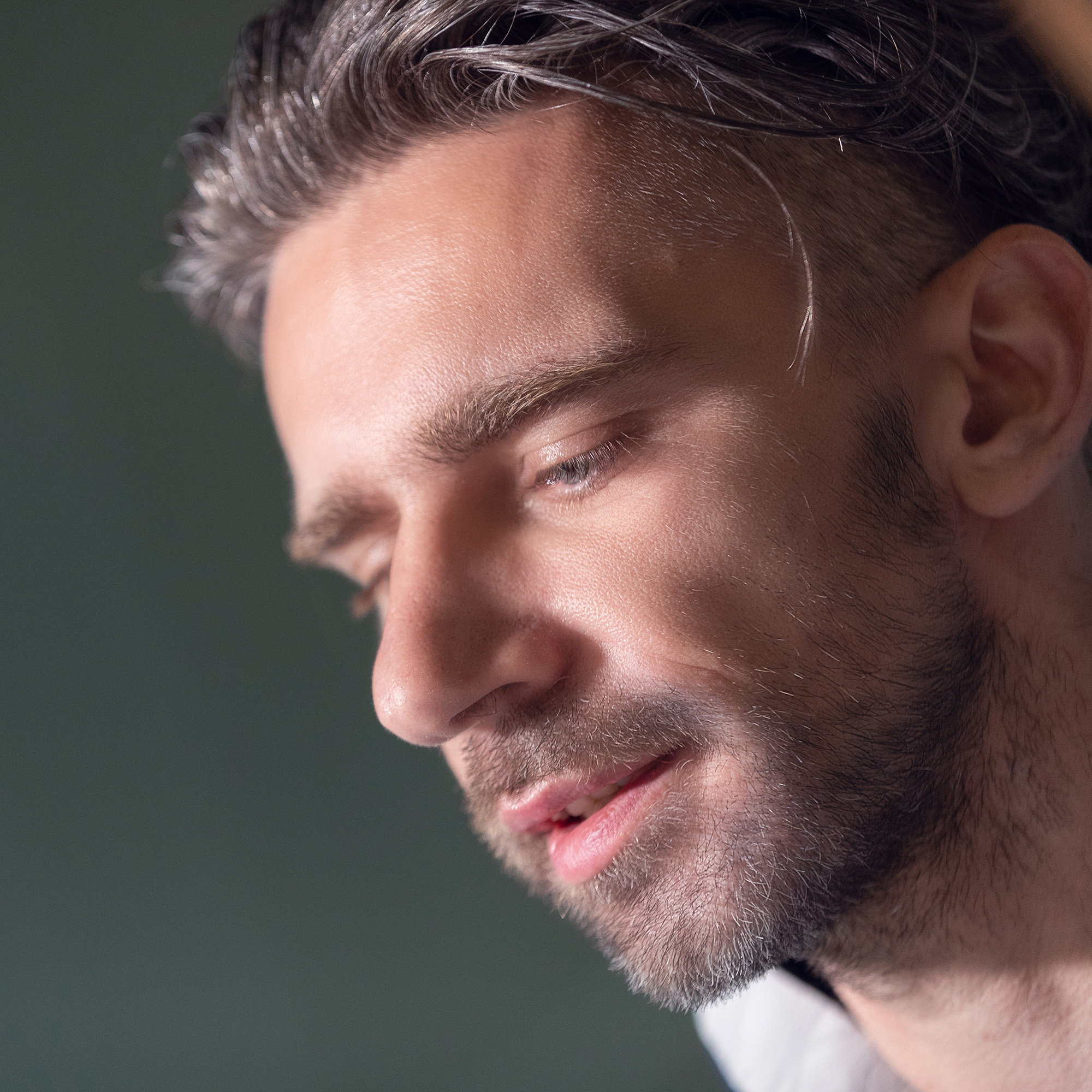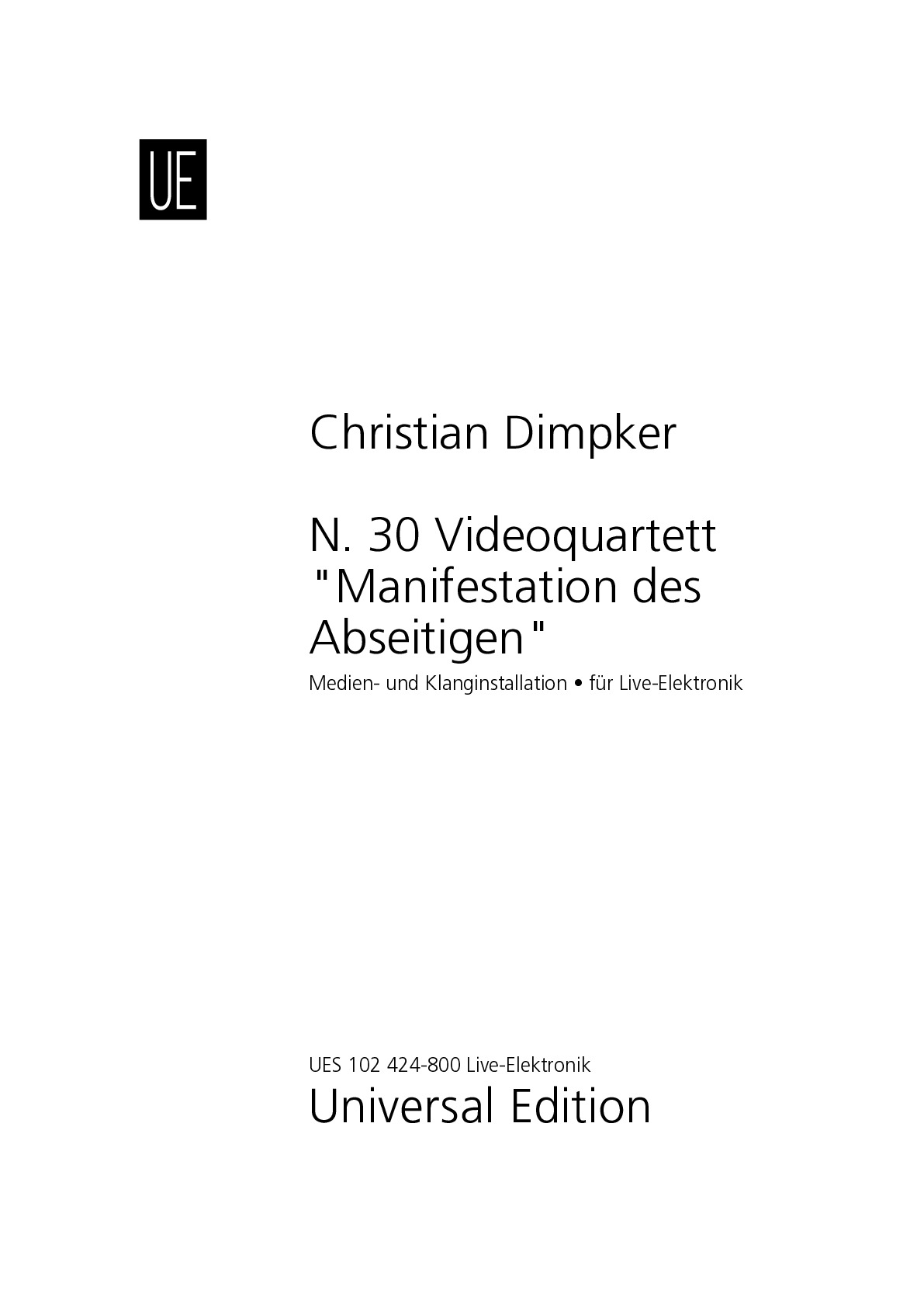

Christian Dimpker
N. 30 Video quartet "Manifestation des Abseitigen"
Duration: 9'
Solos:
live electronics
N. 30 Video quartet "Manifestation des Abseitigen"
Translation, reprints and more

Christian Dimpker
N. 30 Videoquartett "Manifestation des Abseitigen"Type: Noten
Sample pages
Work introduction
The Video quartet "Manifestation des Abseitigen" is based on the second chapter of the treatise Kinetic notations for the visual and performing arts. In the book, methods of notation for video art are developed, which are here used for the first time. The video quartet is a media and sound installation for video cameras, fluorescence microscope, projector, screens, fog machine, fans, microphones, loudspeakers, transducers, synthesizer and electronics. The sound material consists of hidden ultrasound recordings that are detected through transposition, manipulated at the micro level and output via sound sculptures. The visual material is created using thermal imaging and fluorescence spectroscopy. These methods inspect remote movements and organic materials. They are then also reorganised and manipulated on the micro level and finally sent to three LED displays. In addition, a projector installed on the ceiling serves as a complex light instrument that projects a glistening fourth visual plane onto the floor of the room. This is the black and white version of the score, but you can access the coloured version on this page.
What is necessary to perform this work?
This booklet contains two scores. Score A depicts the visual level of the work and score B the acoustic level. There is also an appendix that presents the images in higher resolution. For notational methods and techniques, cf. Dimpker – Extended notation: The depiction of the unconventional and Dimpker – Kinetic notations for the visual and performing arts.
INSTALLATION SETUP: The basic setup of the installation is shown on p. V. The room must be completely darkened. If possible, three walls should be fully covered with three LED screens (or similar technology). These LEDs end at waist height. The image format is adapted to these screens, but can also be stretched if necessary (when using the same interpretation for different rooms). If this set-up causes too much trouble, projectors and screens can be utilised. In this case, the screens will create a room inside a room, while the projectors will reproduce the images (mirror-inverted) from behind. Below the screens, continuous glass plates (ossia: acrylic glass) are installed on two sides and a continuous metal plate on one side. The plates are flush with the LED walls. On the outside of each plate, two transducers (~ 30-150 Hz) are attached, which make the plates vibrate. The plates are supposed to be selected according to their sonic properties. The metal plate also has two large holes. The fans are fitted into these. They run continuously at the lowest speed level. The laser projector is mounted on the ceiling and should cover as large an area as possible. The image format is 1 × 1, the floor needs to be black. Next to the projector, a fog machine is mounted, which also runs continuously at a low level. Fog is characterised by the fact that it sinks to the floor. It makes the laser projection clearly visible. When the mixture is used up, the installation is paused briefly. Attention must also be paid to ventilation. In addition, two high-quality horn loudspeakers (~ 70-20,000 Hz) are installed further outside. They play back a stereo signal that is (potentially) also sent to all transducers. The space should not accommodate too many spectators at once in order not to diminish the viewing experience with regard to the laser projector. The audience can take folding chairs in and should also take them out again. In addition, the back wall can ad libitum be lined with large mirror plates.
BASIC RECORDING (IMAGE / SOUND): Three recordings are made with a thermographic camera. They show spaces / occurrences that are currently threatened and the urge to create something new: 1. Swarm of insects circling around a floodlight in a natural environment at night (by means of a drone). 2. A flock of birds behind bars (camera dolly / shoulder rig necessary). 3. Ascension into the atmosphere during daytime and cloudy, cold weather, not far from a village (with a weather balloon or similar). Further directions can be found in the score. During all shots, the camera is constantly moving. If the movement is not depicted, the interpreters determine how it is executed. The images used in the score are simulations of the images produced by a thermographic camera. In addition, two ultrasonic microphones and two ultrasonic hydrophones with omnidirectional polar pattern (~ 10-150 kHz) in AB configuration are used to make three recordings of natural phenomena: 1. A swarm of bats. 2. A swarm of dolphins hunting. 3. A swarm of grasshoppers or locusts. These recordings should, unless requested otherwise, contain constant movements of the microphones. Existing recordings can also be used. In addition, these recordings are transposed afterwards in such a way that they work well with regard to the frequency response of the transducers and loudspeakers. Impact noise is eliminated by the transposition. It makes sense to create the realisation on-site or to adapt it to the loudspeakers / room afterwards.
ADDITIONAL RECORDINGS: In addition to the basic recordings, photograms and re-footage recordings are produced. For these, one needs so-called light monitors, a video camera, the laser projector, a metal or wooden table, a glass plate on stilts or, respectively, a glass table, colour filters, a Fresnel lens and a so-called drop frame. The set-up is described in detail on p. VI, while the execution of these shots is depicted in the score. In addition, the items listed below (overview equipment) are needed.
FLUORESCENCE MICROSCOPE: In this method, selected molecules are excited to emit light and stand out against a black background. The object of interest is excited through fluorescence labelling recorded by a camera with at least 60-fold magnification. The sample images in the score are courtesy of Nikon Instruments Inc. and are used with their kind permission. The images serve as a template for new recordings, which will differ from these images. However, it should be ensured that the colouring is similar. The samples are described below as well as in the score.
ANIMATION: For the laser projector, an animation is created according to the specifications in the score. Otherwise, there are no requirements concerning the software used to create these images.
ELECTRONIC INSTRUMENT: The utilised synthesizer is based on the historic Roland Juno 106 and, respectively, its digital emulation Softube Model 84 Polyphonic Synthesizer. It is depicted below with their kind permission. However, the method of notation is software-independent and can be used to recreate the synthesizer. Its notation is explained on p. VI. Not all parameters of the device are used, but additional effects and granular techniques (see score).
OVERVIEW EQUIPMENT: Thermographic camera (greyscale, iron, rainbow), video camera and fluorescence microscope (incl. video camera) with the highest possible resolution (min. HD, big sensor, fixed focal length lens and all cameras same quality), drone, camera dolly or shoulder rig, weather balloon, samples for microscope (monkey kidney fibroblast cells, mongoose skin fibroblast cells, bovine pulmonary artery endothelial cells, mouse fibroblast cells), two monitors (e.g. PDP or LED), metal / wooden table, glass table, laser projector, twelve colour filters (bastard amber, rose tint, pale amber gold, special lavender, royal lavender, medium pink, orange red, 1/4 blue, full blue, sky blue, light green, peacock blue – slight variations possible), Fresnel lens, building materials for drop frame, nails, needles, staples, paper clips, plants, flowers, branches, combs, tweezers, yarn, screws, chains, rings, scissors, keys, hair clips, soil, sand, safety pins, various paper clips, screwdriver, pens, fork, knife, key rings and fans (see score for further details) and fan, three LED screens, fog machine, two fans, two ultrasonic microphones, two ultrasonic hydrophones, two microphones (all omnidirectional), two horn speakers, six transducers, two fans, metal and glass (for the installation) as well as computers, hardware, audio and video software at the interpreters’ discretion.
